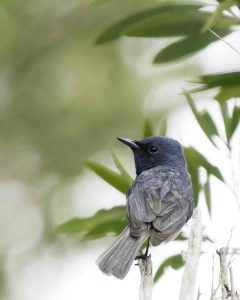Bird of the month – Leaden Flycatcher
When you catch the sun shining off a leaden flycatcher’s feathers you really will see a jewel of the bush.
The male’s luminous, shimmering blue head, bib, and back create a gorgeous contrast to his white belly, whilst the female displays a rufous throat and breast, and white belly.
A highly migratory bird, keep an eye out for it in eucalypt forest, rainforest, mangroves, and coastal scrub.
Some leaden flycatchers vacate our neck of the words and head out over the Torres Strait to winter in southern New Guinea.
As can be gathered from their name, a leaden flycatcher dines on insects it catches while darting from branch to branch, catching its meals in flight in a display of acrobatic prowess.
When it comes time to raise young, the pair will make a nest resembling a deep cup made of strips of bark and grass, woven together with spider webs and lichen, and take turns to incubate.
Unfortunately less than a quarter of all eggs will make it to become a fledgling chick.
The movements of leaden flycatchers are still poorly understood, so if you do spot one please don’t hesitate to become a citizen scientist and record your sighting in the global birding app, eBird.
Melissa Marie
eBird is a global online database of bird observations providing scientists, researchers and amateur naturalists with real-time data about bird distribution and abundance. eBird Australia is a collaborative project managed by the Centre for Biodiversity and Conservation Science.
Your sightings contribute to hundreds of conservation decisions and peer-reviewed papers, thousands of student projects, and help inform bird research worldwide.
Go to ebird.org/australia/home for more information, or download the app from the App Store or Google Play.







